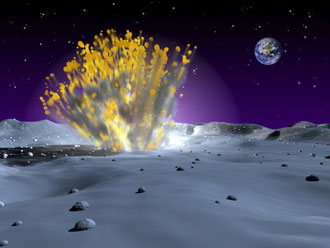Astronomers observing the moon with a 3-meter diameter telescope detected a small eruption northeast of Mara Imbrium

Pictured: NASA artist's rendering showing the impact of a small but powerful meteor on the moon
Astronomers observing the moon with a 3-meter diameter telescope detected a small eruption northeast of Mara Imbrium - the "sea of rain" on the moon. Such an eruption is a phenomenon that is not rare, but it has been captured by instruments so far only once, in 1999.
"People don't look at the moon all the time, everywhere," says Dr. Robert Suggs, director of the environmental team of the Center for Environmental Quality at the Marshall Engineering Center. We tend to think we know everything about the moon, but there is a lot more information that can be gathered there."
When NASA intends to return to the moon, it must understand what happens after such impacts in order to protect the people who will be on the moon. On Earth, the atmosphere vaporizes most small meteorites and leaves no trace other than a brief flash of light. The vacuum environment on the moon means there is nothing to slow down the meteorites before they hit.
"The chance of being hit by a meteorite on the moon is extremely small," says Bill Cook, a senior astronomer at the Marshall Center. The challenge is to learn what will happen when meteorites hit without being slowed down by the Earth's atmospheric friction and what threat these fragments may pose to humans or equipment."
Suggs, who conducts the vulnerability research, uses commercial software tools to examine the video frame by frame, and then he observes a bright flash. The flash of light gradually fades over five frames, each representing a time difference of 1 thirtieth of a second. Suggs called Cook and they both agreed that it was a meteorite impact.
The team also tried to rule out other reasons, but two reasons testified in favor of the meteorite impact - one - the gradual break, and the second reason - the lack of movement. If there had been movement, they would have believed that it was the passing and twinkling of a nearby satellite that happened to pass in the field of view. This movement was also evident within the five frames.
The two also examined the map of the sky and the lunar imaging software and determined that the meteorite was certainly close to a Taurid, part of an annual meteorite shower that was active at the time of impact. Based on the amount of light produced by the object, it seems that its diameter was about 12 cm and it flew at a speed of 100 thousand km/h and it is also possible that it created a crater with a diameter of about 3 meters on the surface of the moon.
The taurids, which reach Earth from the general direction of the Taurus group, are most likely the ancient remnants of the tail of Comet Anka, which orbits the Sun every 3.3 years.
NASA scientists previously studied the phenomenon of meteorites hitting the moon during the Apollo program, but due to a lack of powerful video cameras and image processing systems, they were unable to pick up these tiny and brief flashes. Now anyway, NASA is renewing the development of the new vehicle that will carry explorers back to the moon for a long stay. Suggs and Cook say lunar impact studies will now be more essential than ever. "It will be necessary to protect large facilities on the moon and it will be necessary to use technologies to mitigate the impact, such as that used to protect the astronauts on the space shuttle and the International Space Station. Suggs said.
"We want to support additional measurements so that the security personnel who will be stationed on the moon can use early warning systems, measuring devices for emergency situations and new technologies that will reduce the risk of being hit by flying fragments.
